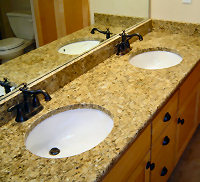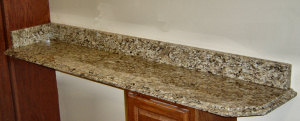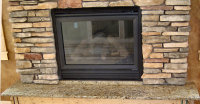
January 30, 2006
Thanks for joining us at Natural Stone Interiors. We hope you find our information helpful. We'd love to hear from you. Just reply to this newsletter. If you like this ezine, "pass it on".
If a friend DID forward this to you and you like what you read, please subscribe here.
If you are unable to view this in HTML color, go to:
Online Newsletter/Backissues
| In This Issue: |
|---|
|
What's new this month at Natural Stone Interiors?
- Curious about seams? Are they necessary? Can they "break"? You can read all about Seams in Granite Countertops here.
- If you're considering granite countertops, make sure to check out the Granite Counter Tops pages. Lots of great information here!
- And, if you're interested in Limestone, we've updated this page. More pictures are coming.
- We want you to know that we respect your privacy. We will never spam, give, sell, or share your e-mail address. You can read our Privacy Policy here.
Idea this Month
Santa Cecilia seems to be one of the most sought after granites. It's a beautiful, warm, and earthy natural stone.
 This coarse grained stone is from Brazil. It's yellow to gray and full of red, pie shaped garnets. The colors vary from light to dark yellow and the amount of garnet in the slabs vary. It's not a bright lemon yellow but more of a softer earthy color.
This coarse grained stone is from Brazil. It's yellow to gray and full of red, pie shaped garnets. The colors vary from light to dark yellow and the amount of garnet in the slabs vary. It's not a bright lemon yellow but more of a softer earthy color.It goes by many different names: Amarelo Santa Cecilia, Giallo Santa Cecilia, Juperana Santa Cecilia, and St Cecilia to name just a few. The name "Cecilia" is usually included in the name somewhere.
 The uses vary from unique kitchen counter designs, to bathroom vanities, to simple fireplace hearths. This stone is best suited for indoor use.
The uses vary from unique kitchen counter designs, to bathroom vanities, to simple fireplace hearths. This stone is best suited for indoor use.Since it is a coarse grained stone, and has a water absorption rate of around 0.36%, it needs to be sealed. In fact, most yellow "granites" need to be sealed.
 Don't be put off by the need to seal. The quality stone care products available today make sealing stone a breeze. AND, there are Granite Sealers available where you only have to seal every ten years or so! Choose a stone you love! You'll live with it a long time.
Don't be put off by the need to seal. The quality stone care products available today make sealing stone a breeze. AND, there are Granite Sealers available where you only have to seal every ten years or so! Choose a stone you love! You'll live with it a long time.(Can't see the pictures?) Try going to view and click allow blocked images. Or, go to the page online:Picture Online
Info, Hints and Tips: From the Fabricator
How To Seal Granite Countertops
- Uniformly apply the sealer to your countertop using a clean white rag. You can use a brush instead of a rag.
- Let the sealer absorb into the stone for approximately 3 to 4 minutes.
- When the sealer is almost dry, apply a little more sealer on your granite and then rub it in with a dry, clean rag.
- Repeat on the next section of stone until your entire countertop is sealed.
- Wait at least two hours and then apply a second application. The wait time depends on your specific brand of sealer.
- Work in a small area, 4 to 5 square feet.
- If your granite needs to be sealed, at least 2 coats of sealer is recommended.
- Wait at least 2 hours before reapplying sealer.
- To find out if your stone is sufficiently sealed, spill water on your countertop, wait for about 1/2 hour, then wipe it up. If your stone does not darken, your countertop is sufficiently sealed.
You'll Need
- Clean white rag or brush.
- A good Quality Impregnator Sealer.
RECAP of the months "Question of the Week"
Where is Natural Stone found?
Natural stone is found in countries all over the world... from Angola to Zimbabwe. Depending on the type of stone, it is found within the earth, mountains, low lying areas such as plains, or former sea beds where the collection of sediment has occurred.
12//11/05
How do I attach my dishwasher to the stone countertop?
It is recommended that you do not attach the dishwasher directly to your Natural Stone countertop. Most dishwasher manufacturers have either side mount or floor mount brackets available.
12/18/05
Can you tell me a little bit more about "sealing" Natural Stone?
Sealers in the stone industry are called impregnators because they impregnate the interior of the stone with silicones and resins that go through the pores of the surface. Stone sealers do to stone what exterior wood sealers do to wood. They protect the interior of the material.
12/25/05
What is the difference between honed and polished natural stone?
The look first and foremost. A polished finish is shiny; it reflects light. A honed stone has a matte like finish or a slight sheen to it. Staining can be more of an issue with honed granite. The pores of the stone are left more open and therefore the honed stone is more susceptible to staining. Aluminum and copper clad pots tend to leave more marks on the surface of an honed stone also. Use a good quality Impregnating Sealer to help prevent stains.
Be original,
Darren & Carolyn
www.naturalstoneinterior.com